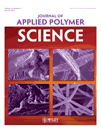Characterizations on the amidized multiwalled carbon nanotubes grafted with polyaniline via in situ polymerization
Abstract
A multiwalled carbon nanotubes (MWCNTs) were carboxylated after refluxing with sulfuric and nitric acids. These attached carboxylic acid groups were further condensated with o-phenylene diamine into amide catalyzed by dicyclohexyl carbodiimide (DCC). The obtained amidized MWCNTs were in situ-polymerized with aniline monomers to graft a conducting polyaniline (PANI) onto MWCNT (ES-g-MWCNTs) through the polymerization occurring in the ortho- and meta-positions. The reduced conductivity of the MWCNT after carboxylation can be recovered after grafting with PANI, which owns a strong λmax at the near infrared region due to the extended conjugation from MWCNTs to PANI. Transmission electronic microscopic pictures show a gradual broadening of the MWCNT diameter after carboxylation, amidization, and polymerization. The weight loss from the thermogravimetric thermograms due to the carboxylations of MWCNTs, amidized MWCNTs, and the PANI grafted MWCNTs into CO2 can be used to estimate the degree of carboxylation, amidization, and grafting of PANI. The degree of carboxylation of MWCNT calculated from ESCA spectrum is around 23% close to that estimated from TGA thermogram. The doping level of redoped PANI-grafted MWCNT is found to be 27.78% much less than the maximum 50% of neat PANI. © 2011 Wiley Periodicals, Inc. J Appl Polym Sci, 2011




